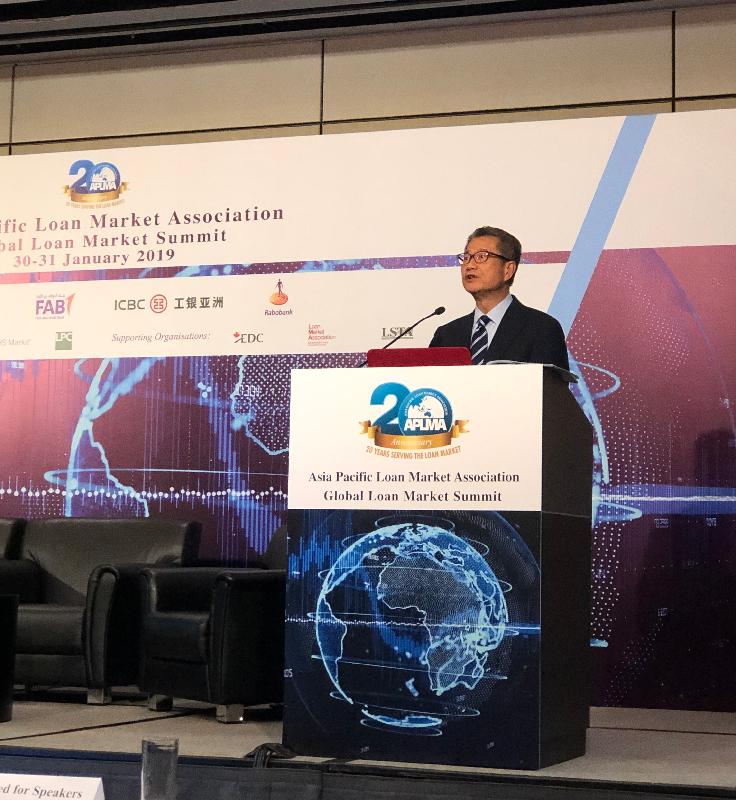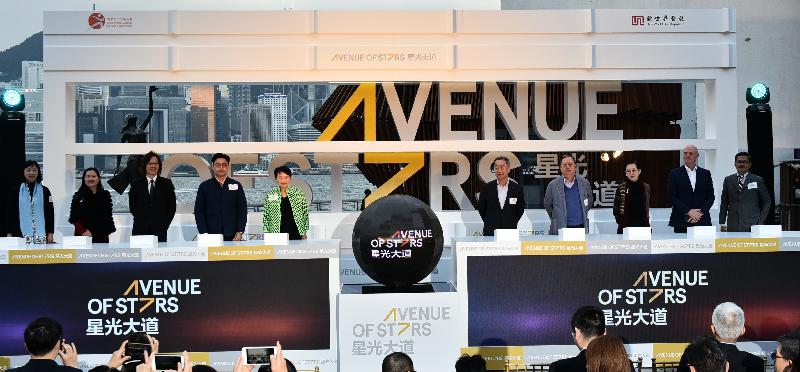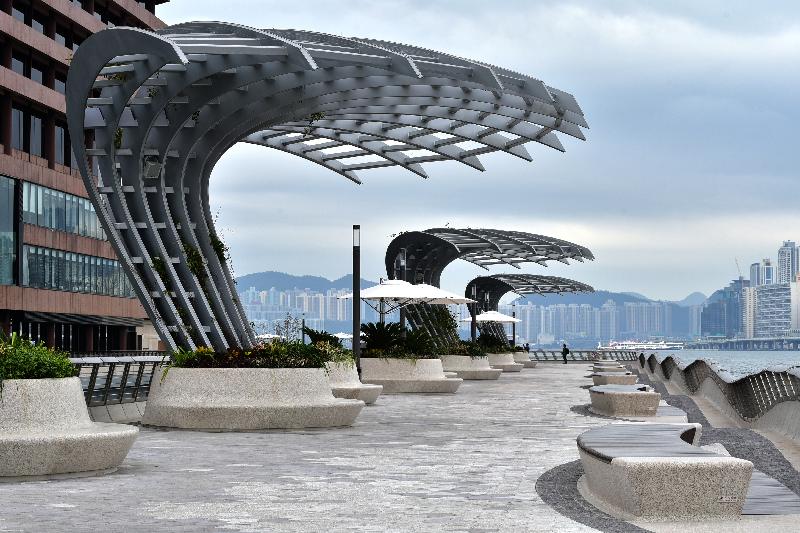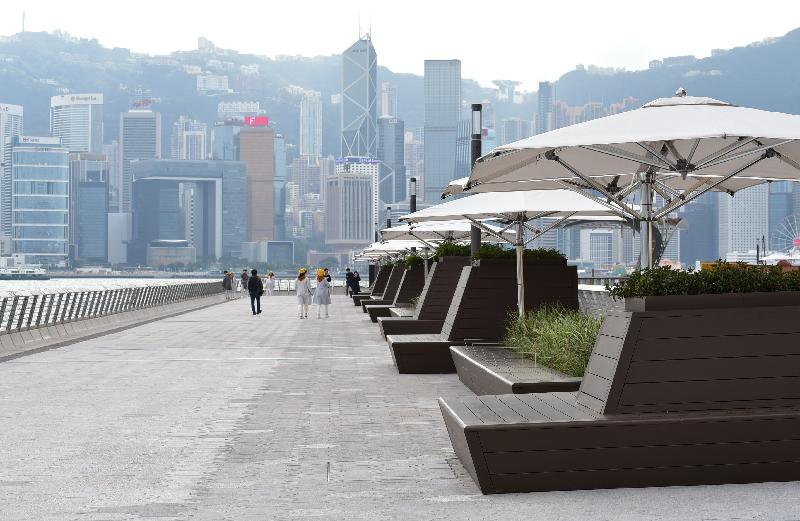Following is the speech by the Financial Secretary, Mr Paul Chan, at the Global Loan Market Summit of the Asia Pacific Loan Market Association (APLMA) today (January 30):
Phil (Chairman of the APLMA, Mr Phil Lipton), Andrew (Chief Executive Officer of the APLMA, Mr Andrew Ferguson), distinguished guests, ladies and gentlemen,
Good afternoon.
I’m pleased to be here for this year’s Global Loan Market Summit, the 7th annual Summit of the Asia Pacific Loan Market Association. My thanks to the Association for giving me this welcome opportunity to speak to you.
My congratulations as well to the Association, which celebrates its 20th anniversary this year. This is definitely a milestone in the Association’s continuous contribution to Hong Kong’s financial services sector in the past two decades.
I’m grateful for your good work in promoting the growth and liquidity in the primary and secondary loan markets of Hong Kong and the region as a whole. I’m grateful too, for your continuing support of best practices in the syndicated loan market.
In Andrew’s clear and compelling address, we noted the resilience of the syndicated loan market. Resilience has long been a way of life and business for Hong Kong. Our resilience, our adaptability and our compelling knack for creating connections have served Hong Kong well over the years and the decades. And I have no doubt that they will see us through the challenges of today, and help us all excel tomorrow.
I note that financial technology (fintech) and green finance are among the key themes of this year’s Summit. They are also central policy goals of the HKSAR Government.
And I’m pleased to say that our fintech sector is fast emerging, fast expanding.
Currently, our fintech cluster has grown into a vibrant community of over 500 companies including start-ups, stationing in our Cyberport, Science Park and private co-working spaces dotted all over the city.
International players such as the Accenture Fintech Innovation Lab, Deloitte Asia Pacific Blockchain Lab and the Floor from Israel have established a notable presence in Hong Kong. Tencent also signed an agreement with Science Park just yesterday to enhance co-operation in the development and application of fintech in Hong Kong.
Hong Kong is undoubtedly an ideal launch pad for those seeking a future in fintech. This is evidenced by the investment in Hong Kong-based fintech companies – which exceeded US$500 million in 2017, doubling the amount in 2016.
The Government is determined to keep this fintech momentum rolling. Allow me to highlight a few of the latest fintech developments in the city:
The Hong Kong Monetary Authority (HKMA) launched in last September the Faster Payment System which provides full connectivity of retail payments. It connects banks and shared-value facility operators, enabling the public to transfer funds instantly in both Hong Kong dollars and Renminbi, anytime, anywhere, using only mobile phone numbers or email addresses.
HKMA will start to issue virtual banking licences in this quarter, providing the Hong Kong public with more efficiency and more banking choices.
A Banking Made Easy initiative was introduced in September 2017 to reduce regulatory friction to enable banks to provide better customer experience in the online banking environment.
The Fintech Career Accelerator Scheme has been launched since December 2016 with a view to expanding the fintech talent pool in Hong Kong.
The banking sector’s Open Application Programming Interface framework is also being implemented this year in phases, enabling collaboration between banks and third-party service providers on offering innovative and integrated financial services.
To step up cross-border collaboration in fintech, we have entered into fintech co-operation agreements with regulators or governments in the UK, Singapore, Dubai and Shenzhen, just to name a few. The Hong Kong FinTech Week, which took place in last November in both Hong Kong and Shenzhen, was the world’s first cross-border fintech event. More than 8,000 business leaders, start-ups, investors, regulators, investors and more from over 50 countries and regions had joined us.
On top of fintech, we are also committed to realising a smart green Hong Kong.
As a global financial centre and the world’s offshore Renminbi business hub, Hong Kong has what it takes to fast-track the development of green finance, to become a premier financing centre for Mainland and international companies looking to raise funds for their green projects.
To that end, the Government has taken several measures to jump-start the market for green bonds.
The Hong Kong Quality Assurance Agency launched its Green Finance Certification Scheme last year, providing third party conformity assessments for issuers on their green debt instruments. Last June, we launched a Green Bond Grant Scheme to subsidise green bond issuers making use of this certification scheme to encourage more corporate green bond issuance in Hong Kong.
In the next 10 months, we will issue our first government green bond under the Government Green Bond Programme, which has a borrowing ceiling of HK$100 billion.
And for the promotion of our bond market in general, we launched a Pilot Bond Grant Scheme last year to offer grants to first-time issuers here to cover part of their issuance expenses. We also offered tax exemptions to invest income and trading profits arising from qualifying debt instruments to encourage investor participation in the bond market. In fact, in the first half of 2018, we have already attracted 15 issues of Green Bond in Hong Kong raising an aggregate amount of US$8 billion.
I am now preparing the Government Budget for 2019/20. If you have suggestions on how we could better promote the development of our bond market or green finance, please do not hesitate to let me know.
Just last month, China celebrated the 40th anniversary of its reform and opening up. That historic development has profoundly changed the nation, and the lives of its people. And we can all be proud of the continuous role that Hong Kong has played in the process. But more than a contributor, we have been a grateful beneficiary of China’s landmark reform and opening up as well.
Going forward, the continuing reform and opening up of China will offer Hong Kong tremendous opportunities, particularly under the Belt and Road Initiative and the Guangdong-Hong Kong-Macao Greater Bay Area development plan.
Hong Kong is uniquely well positioned to be the financing hub for Belt and Road infrastructure projects. Project owners can look to Hong Kong to raise capital and seek financing through a variety of means, from IPOs to post-listing arrangements, bond issuances, syndicated loans and more.
In this regard, HKMA has set up an Infrastructure Financing Facilitation Office to facilitate infrastructure investment and financing. The Securities and Futures Commission has issued guidelines setting out how infrastructure project companies can be listed on our Stock Exchange. In fact, we are also ideally suited to be the risk management, corporate treasury services and professional services hub for mega infrastructure projects as well.
As for the Greater Bay Area development, it is an ambitious plan encompassing Hong Kong, Macao and nine cities in the Guangdong Province. The Greater Bay Area brings together a collective population of nearly 70 million. While it accounts for only 5 per cent of the Mainland’s population, the Greater Bay Area is responsible for 12 per cent of the nation’s GDP, amounting to about US$1.5 trillion – that is equivalent to the GDP of Korea or Australia. We see tremendous opportunities for Hong Kong’s financial services in this development.
On asset and wealth management, we are working to make Hong Kong a more attractive domicile for funds. We have put in place a legal framework for open-ended fund companies, providing an alternative choice for fund structure. We are also looking into the introduction of a limited partnership regime for private equity funds in Hong Kong. And we have introduced a bill into the Legislative Council offering profits tax exemption to onshore funds, in addition to offshore funds, so that all funds regardless of structure, size or purpose can enjoy tax exemption.
We will also expand our fund distribution network and deepen the Connect arrangements. Currently, mutual recognition of funds arrangements have been reached with the Mainland, Switzerland, France, the UK and Luxembourg. Together with Stock Connects and Bond Connect, Hong Kong is a unique gateway between international markets and investors and their counterparts in the Mainland, while helping in the internationalisation of the Renminbi.
In anticipation of more Mainland companies going global and the Greater Bay Area developing into the international innovation and technology hub of China, we implemented a new listing regime last April to allow companies in the emerging and innovative sector with weighted voting rights structures, as well as pre-revenue pre-profit biotech companies, to list on the Stock Exchange. In doing so, the attractiveness and competitiveness of Hong Kong’s listing platform is further enhanced. Last year, we topped the world again in terms of funds raised through IPOs. This is the sixth occasion in the past 10 years.
In short, ladies and gentlemen, Hong Kong will continue to do what it has done, for so long and so well. And that’s building the connections and platforms that create opportunities. The opportunities that help Hong Kong companies and the companies that work with us excel.
Speaking of excelling, the APLMA Awards will be announced tonight. I know it will be a very special evening. Allow me to congratulate this year’s winners, without naming names.
And with the Year of the Pig less than a week away, I wish the Asia Pacific Loan Market Association, and each and every one of you here and your family, a happy, healthy and prosperous Chinese New Year.
Thank you.










